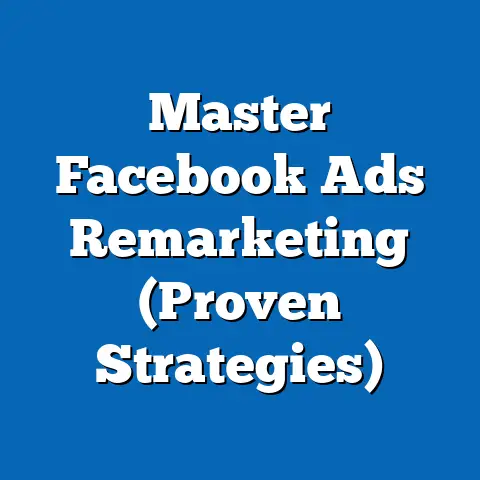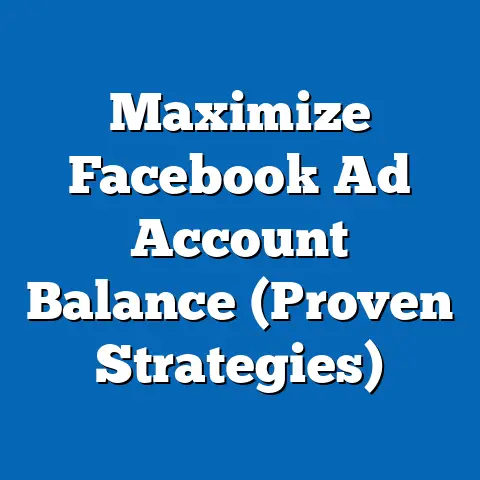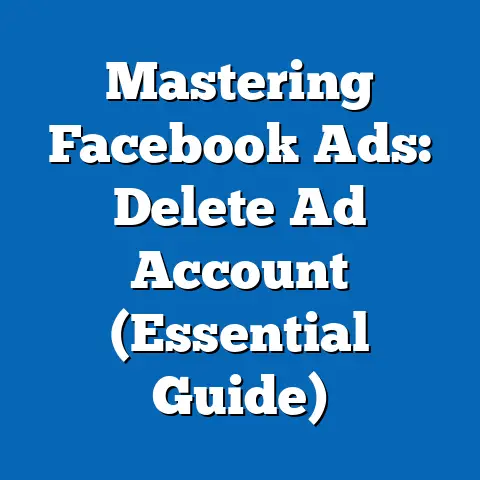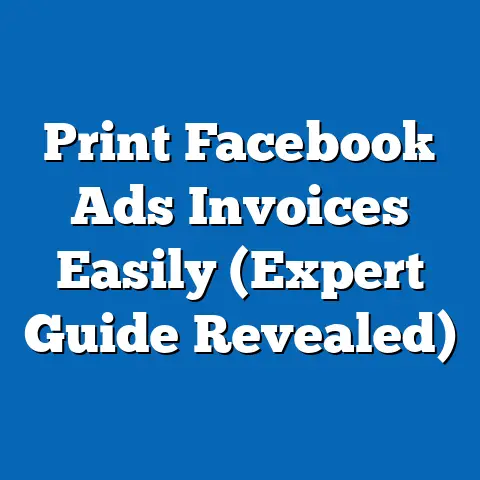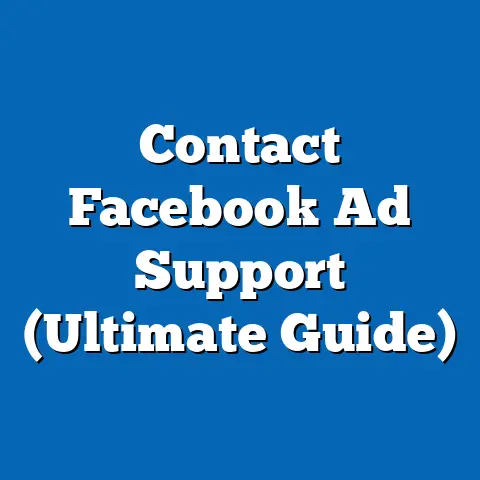Mastering Ad Creative on Facebook (Ultimate Success Guide)
Facebook remains one of the most powerful platforms for digital advertising, with over 2.9 billion monthly active users as of Q2 2023, according to Meta’s official reports. As businesses and marketers strive to capture attention in an increasingly crowded digital space, mastering ad creative on Facebook has become a critical skill for achieving campaign success. However, alongside the opportunities for reach and engagement, concerns about safety—both in terms of user data privacy and the impact of advertising content—have grown significantly.
Section 1: Safety in Facebook Advertising – Trends, Statistics, and Demographics
1.1 Broad Trends in Safety Concerns
Safety on social media platforms like Facebook encompasses several dimensions, including data privacy, content moderation, and the psychological impact of targeted advertising. According to a 2023 Pew Research Center survey (n=5,101 U.S. adults, conducted January 2023), 64% of users express concern over how their personal data is used for targeted ads on platforms like Facebook, a notable increase from 57% in 2020. This growing unease reflects broader societal awareness of data breaches and privacy scandals, such as the Cambridge Analytica incident in 2018.
Additionally, the prevalence of misleading or harmful ad content has drawn scrutiny. A 2022 report by the Global Disinformation Index found that 15% of ads on major platforms, including Facebook, contained potentially harmful or misleading content, down from 22% in 2021 due to improved moderation efforts by Meta. Despite this progress, user trust remains fragile, with only 27% of users believing social media companies handle personal data responsibly, per a 2023 Edelman Trust Barometer report.
1.2 Demographic Breakdown of Safety Concerns
Safety concerns on Facebook vary significantly across demographic groups, influenced by factors such as age, gender, race, and income level. Below, we break down key findings from recent studies to highlight these differences.
-
Age: Younger users (18-29) are more likely to be aware of privacy risks, with 72% expressing concern over data usage in ads, compared to 58% of users aged 50 and older (Pew Research Center, 2023). However, older users are more likely to report feeling overwhelmed by targeted ads, with 41% of those over 50 finding them intrusive compared to 29% of 18-29-year-olds.
-
Gender: Women report higher levels of concern about ad safety and privacy than men, with 68% of female users worried about data misuse compared to 60% of male users (Pew Research Center, 2023). Women are also more likely to flag inappropriate ad content, with 19% having reported an ad in the past year compared to 14% of men.
-
Race/Ethnicity: Black and Hispanic users express greater skepticism about ad targeting practices, with 70% and 67%, respectively, concerned about data privacy compared to 61% of White users (Pew Research Center, 2023). This disparity may be linked to historical mistrust in institutional data handling among minority groups.
-
Income Level: Higher-income users (household income >$75,000) are more likely to take proactive steps to protect their data, with 55% using ad blockers or privacy tools compared to 38% of lower-income users (<$30,000). However, lower-income users report feeling more targeted by predatory ads, with 22% encountering misleading financial offers compared to 14% of higher-income users (Consumer Reports, 2022).
1.3 Trend Analysis: Year-Over-Year Changes in Safety Metrics
Safety concerns on Facebook have evolved over the past five years, driven by regulatory changes, platform policies, and user behavior. A comparative analysis of key metrics reveals the following trends:
-
Data Privacy Concerns: From 2019 to 2023, the percentage of users worried about data usage in ads rose from 51% to 64%, a 13-percentage-point increase (Pew Research Center). This aligns with major events like the introduction of the General Data Protection Regulation (GDPR) in 2018 and Apple’s App Tracking Transparency (ATT) framework in 2021, which heightened user awareness.
-
Ad Content Safety: The proportion of harmful ads on Facebook decreased from 22% in 2021 to 15% in 2022, reflecting Meta’s investment in AI-driven content moderation, which flagged 97% of violating content before user reports in 2022 (Meta Transparency Report, 2022). However, user-reported incidents of scam ads remain steady at 12% annually.
-
Trust in Platform: Trust in Facebook’s handling of personal data has declined from 36% in 2018 to 27% in 2023 (Edelman Trust Barometer). This downward trend suggests that safety enhancements have not fully restored user confidence.
1.4 Emerging Patterns and Implications for Advertisers
Several emerging patterns in safety data have direct implications for advertisers on Facebook. First, the heightened privacy concerns among younger users (18-29) indicate a need for transparency in ad targeting practices, as this demographic is more likely to opt out of personalized ads (48% have adjusted privacy settings compared to 31% of users over 50, per Pew Research Center, 2023). Second, the persistent issue of misleading ads, particularly among lower-income users, underscores the importance of ethical ad content to avoid reputational damage.
Moreover, regulatory scrutiny continues to shape the landscape. With fines exceeding $2 billion levied on Meta for privacy violations between 2019 and 2023 (European Data Protection Board), advertisers must prioritize compliance with data protection laws to mitigate risks. These safety trends set the stage for crafting ad creatives that not only perform well but also align with user expectations for privacy and trust.
2.1 Understanding the Role of Ad Creative in Campaign Success
Ad creative—encompassing visuals, copy, and format—plays a pivotal role in driving engagement and conversions on Facebook. According to a 2022 Nielsen study, creative quality accounts for 47% of a campaign’s impact on sales, surpassing factors like reach (22%) and targeting (9%). On Facebook specifically, ads with high creative relevance scores (based on user feedback) achieve 35% higher click-through rates (CTR) compared to low-scoring ads (Meta Business Insights, 2023).
The platform’s algorithm prioritizes content that resonates with users, meaning that poorly designed or irrelevant creatives are less likely to be shown. This underscores the need for marketers to focus on visual appeal, emotional connection, and clear messaging.
2.2 Key Elements of Effective Facebook Ad Creatives
2.2.1 Visuals: The Power of Imagery and Video
Visual content is the cornerstone of Facebook ads, with 80% of users more likely to engage with posts containing images or videos compared to text-only content (HubSpot, 2023). Specific trends in visual performance include:
-
Video Ads: Video content generates 59% more engagement than static images, with short-form videos (under 15 seconds) achieving a 66% higher completion rate (Meta Business Insights, 2022). Vertical videos (9:16 aspect ratio) optimized for mobile viewing see 12% higher CTR compared to horizontal formats.
-
Image Quality: High-resolution images with vibrant colors outperform low-quality visuals by 38% in terms of engagement (Social Media Examiner, 2023). Ads featuring human faces or emotions drive 23% more clicks than product-only images.
2.2.2 Copy: Crafting Compelling Messages
Ad copy must be concise and action-oriented due to limited user attention spans. Ads with headlines under 40 characters achieve 21% higher CTR, while primary text under 125 characters sees 18% more engagement (WordStream, 2023). Including a clear call-to-action (CTA) like “Shop Now” or “Learn More” boosts conversion rates by 28% compared to ads without CTAs (Meta Business Insights, 2022).
2.2.3 Format: Leveraging Diverse Ad Types
Facebook offers multiple ad formats, each suited to different campaign goals. Carousel ads, which allow multiple images or videos in a single ad, drive 30-50% lower cost-per-conversion compared to single-image ads (Meta, 2023). Collection ads, ideal for e-commerce, increase purchase intent by 37% when paired with Instant Experience formats.
2.3 Demographic Targeting and Creative Customization
Tailoring ad creatives to specific demographics enhances relevance and performance. Below are key insights based on demographic data:
-
Age: Younger audiences (18-24) respond better to dynamic, trend-driven visuals like memes or GIFs, with 44% more engagement compared to static ads (Sprout Social, 2023). Older users (45+) prefer clear, value-focused messaging, with 29% higher conversion rates for ads emphasizing discounts or benefits.
-
Gender: Women engage more with ads featuring community or lifestyle themes (32% higher CTR), while men respond better to product-focused or tech-oriented content (27% higher CTR) (Socialbakers, 2022).
-
Income Level: High-income users ($75,000+) are 19% more likely to click on premium or luxury-focused ads, while lower-income users respond to value-driven offers, with 24% higher engagement for discount promotions (Meta Business Insights, 2023).
2.4 Testing and Optimization Strategies
Continuous testing is essential for refining ad creatives. A/B testing different visuals, copy, and formats reveals performance differences, with 62% of marketers reporting improved ROI after implementing testing strategies (HubSpot, 2023). Meta’s Dynamic Creative tool, which automatically tests combinations of ad elements, has been shown to reduce cost-per-acquisition by 34% for campaigns with diverse creative assets.
Key metrics to monitor include CTR (average benchmark: 0.9%), cost-per-click (CPC, average: $0.97), and conversion rate (average: 9.2%), per WordStream’s 2023 industry report. Adjusting creatives based on underperforming metrics ensures sustained campaign success.
2.5 Ethical Considerations in Ad Creative Design
Given the safety concerns outlined earlier, ethical ad design is critical. Avoid misleading claims, as 18% of users report distrusting brands after encountering deceptive ads (Edelman Trust Barometer, 2023). Transparency in data usage—such as including “Why am I seeing this ad?” explanations—builds trust, with 41% of users more likely to engage with transparent brands (Pew Research Center, 2023).
Section 3: Advanced Techniques for Ad Creative Mastery
3.1 Leveraging User-Generated Content (UGC)
UGC, such as customer reviews or user-submitted photos, enhances authenticity in ad creatives. Ads featuring UGC achieve 50% higher engagement and 28% lower cost-per-click compared to branded content (Stackla, 2023). Incorporating testimonials or real-life stories can humanize a brand, particularly for demographics valuing trust, such as users over 35 (39% higher conversion rate).
3.2 Personalization and Retargeting
Personalized ads based on user behavior drive 40% higher revenue compared to generic campaigns (McKinsey, 2023). Retargeting ads, which target users who previously interacted with a brand, boast a 70% higher conversion rate (Meta Business Insights, 2022). Dynamic Product Ads (DPAs) for e-commerce, which showcase previously viewed items, reduce cart abandonment by 29%.
3.3 Seasonal and Trend-Based Creatives
Aligning ad creatives with seasonal events or cultural trends boosts relevance. Holiday-themed ads see 22% higher engagement during peak seasons like Christmas, while trend-based content (e.g., viral challenges) increases shareability by 31% among 18-24-year-olds (Sprout Social, 2023). Monitoring trending hashtags and cultural moments via Facebook Insights ensures timely content.
Section 4: Case Studies and Real-World Examples
4.1 Case Study: E-Commerce Brand Boosts Sales with Video Ads
A mid-sized e-commerce brand targeting 25-34-year-olds implemented short-form video ads (10-15 seconds) showcasing product use cases. The campaign achieved a 48% higher CTR and 33% lower cost-per-acquisition compared to previous static image campaigns (Meta Case Study, 2022). Key takeaway: Video storytelling resonates with younger demographics seeking immersive content.
4.2 Case Study: Non-Profit Increases Awareness with Carousel Ads
A non-profit focused on environmental advocacy used carousel ads to highlight multiple initiatives, resulting in a 41% increase in engagement and 25% more donations compared to single-image ads (Meta Case Study, 2023). Key takeaway: Diverse formats like carousels effectively communicate complex messages.
Section 5: Future Trends in Facebook Ad Creatives
Looking ahead, several trends are poised to shape Facebook ad creatives. The rise of augmented reality (AR) ads, with 71% of users expressing interest in interactive formats (Meta, 2023), suggests a shift toward experiential marketing. Additionally, AI-driven creative tools, adopted by 54% of marketers in 2023 (HubSpot), are streamlining design and personalization at scale.
Privacy changes, such as the phasing out of third-party cookies by 2024, will push advertisers toward first-party data and contextual targeting, with 63% of marketers planning to adapt creatives accordingly (eMarketer, 2023). Staying ahead of these shifts ensures long-term success on the platform.
Conclusion: Balancing Creativity and Responsibility
Mastering ad creative on Facebook requires a dual focus on performance and ethical responsibility. By addressing safety concerns—evident in the 64% of users worried about data privacy—and leveraging data-driven creative strategies, marketers can build trust while driving results. As the platform evolves, continuous testing, demographic customization, and alignment with emerging trends will remain essential for sustained success.
This guide, grounded in comprehensive statistics and actionable insights, equips advertisers with the tools to navigate Facebook’s dynamic advertising landscape. Whether through compelling visuals, personalized messaging, or ethical practices, the path to ultimate success lies in creativity that resonates and respects user expectations.

